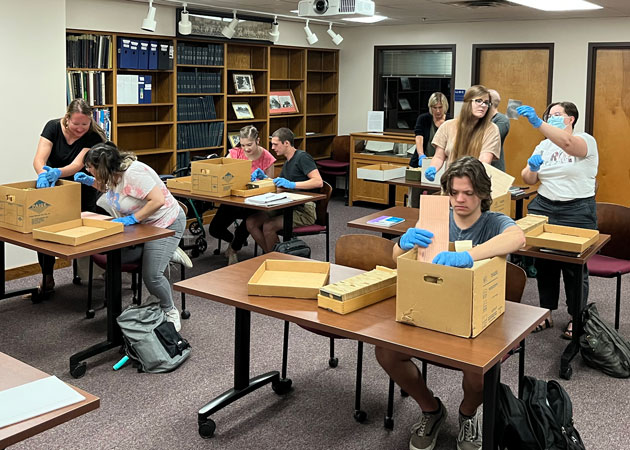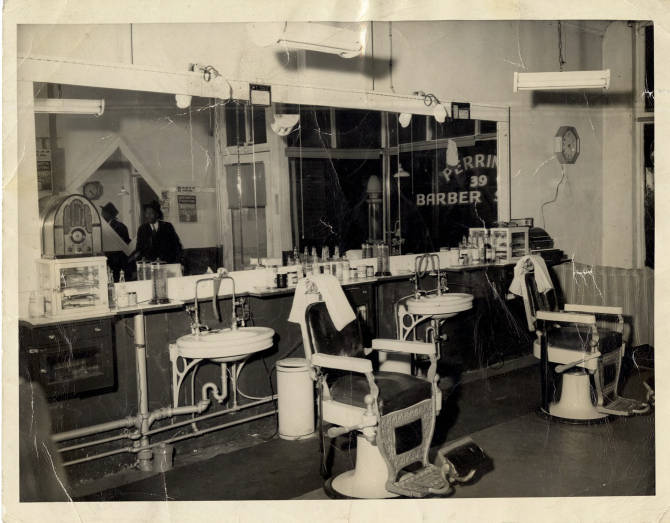UA history students help document Black businesses for Green Book
Graduate students at The University of Akron are helping to make contributions to local history through a collaborative venture called Green Book Cleveland, a project to preserve stories of Black leisure and entertainment in Northeast Ohio.

Graduate students sort through archival materials.
“The Negro Motorist Green Book” served a very important role in the lives of Black motorists. From 1936-1966 it was published as a travel guide advertising places of business that were welcoming to people of color. The guide, established by Victor Hugo Green, a postal carrier in New York City, included a number of establishments such as motels, restaurants, nightclubs, tailors, barbershops, beauty salons, drug stores, liquor stores, gas stations and garages.
While the book sought to be as inclusive as possible, not all locations across the country could be captured. The Green Book Cleveland project began in 2021 as a way to map and further document Northeast Ohio Green Book sites, as well as places that never appeared in any of its 23 national editions. The venture began as a restorative history project for students at Cleveland State University with Dr. Mark Souther, professor and director of the Center for Public History and Digital Humanities, to collect missing locations from the Cleveland area.
Akron was an important travel destination for many Black Americans, especially during the rubber boom from WWI through the 1950s. Dr. Gregory Wilson, professor of history at The University of Akron, and nine graduate students from UA’s Department of History, joined the project in fall 2023 to collect missing data from the Akron area.

Places such as Perrin's Barber Shop were important to visitors and residents alike. *Photo courtesy of the Opie Evans Papers at The University of Akron Archives and Special Collections of University Libraries
Collecting the locations has been a labor of love. To discover locations, students scoured local newspaper archives, reviewed sources such as phone books, the Akron Negro Directory from 1940 and two other 1920s-era publications, websites, and oral histories of Black individuals who grew up in the community. They also relied heavily on information from late Akron resident and well-known educator, Dr. Shirla R. McClain, referencing data provided in her doctoral dissertation The Contribution of Blacks in Akron's History: 1825–1975.
The construction of the never-completed Akron Innerbelt, a highway that was to connect downtown Akron to the suburbs, caused the demolition of many structures which were once prominent Green Book locations, such as the Mathews Hotel on the corner of Perkins and Main Street.
“Projects like this are important,” said Wilson. “It's much more than [identifying the location of] a beauty shop and a service station and a hotel. It speaks to a much larger history that I think is really critical, especially now in our current day and age. Akron had a thriving community that welcomed visitors from around the county. For our Black community to be recognized for their role in history and for their stories to be told, the more we can do that, the better.”
Student Melanie Mohler shares that it has been an interesting journey to follow the journey of residents who developed the businesses listed in the Green Book.
She mentions Thomas Dunagan, a Black business owner who came to Akron from Alabama during the great migration in the late 1910s. He operated a service station and eventually opened a bar next door called Dunagan’s Tavern.
“It was really interesting to do the research,” Mohler said. “Sometimes it was called Dunagan’s Bar, so again it was just searching the results that would come up and seeing the different ways it was referred to in the newspaper over the years.”
“They were thriving businesses,” she said. “But today they're just empty lots, unfortunately.”
As a former dancer, student Stephanie Godsey was intrigued by one resident who owned the . J.C. Wade was a tap dancer who performed in New York City in the late 1920’s and early 1930’s. He opened a studio in Akron in 1933 where he taught ballet and tap to his students, who were Black and white. He was the first Black dance teacher and dance studio owner in Akron.
In addition to learning about Akron’s rich history, Akron students also felt a deeper connection to the individuals who lived called Akron home or visited.
“I think it's always a shock to us when we're just used to going about our daily life and we don't always consider what other people have had to go through,” said student Hannah Kemp-Severence. “And so that part is a major shock where you're like, yes, we live in Ohio, where in an area that was, you know, a northern area and it's supposed to have a lot less segregation. And yet you find out that's really not the case.”
Souther points out that the goal of the project is to restore visibility to places that live in people's memory but have in most cases been erased from the landscape. “Green Book Cleveland is intended as a restorative history project to preserve and share stories of places that might otherwise be absent in the city's and region's history and aims to generate awareness of African American history in Northeast Ohio that moves beyond the Underground Railroad and the Civil Rights Movement. Leisure and recreation shouldn't be seen as simply lighthearted or frivolous; Black Northeast Ohioans often struggled to overcome bars to entry in leisure and recreation spots and found it necessary to carve out their own spaces. Green Book Cleveland also seeks to use emerging knowledge of these place-based histories to encourage commemorative actions and even to contribute to larger efforts to bring more equitable access to green space in the region.”
Other partners in the project include the Cuyahoga Valley National Park, who was awarded a National Park Foundation Mellon Humanities Postdoctoral Fellowship for 2023-25 on the basis of this collaboration. It includes representatives from Cleveland Metroparks, Summit Metro Parks, the Conservancy for Cuyahoga Valley National Park, The Trust for Public Land, ThirdSpace Action Lab, Ohio & Erie Canalway National Heritage Area, and the University of Akron.
While many of Dr. Wilson’s graduate students recently finished their work on the project, they are happy that others at UA will pick up where they let off and expand the Akron digital map and narratives. Dr. Hilary Nunn, professor of English, and her class plan to jump in next.
Dr. Wilson also hopes that the community can get more involved. “What I think would really give it a lot more strength and power is to get family members who are connected to these places to share their stories and their memories.”
Learn more about Green Book Cleveland at greenbookcleveland.org.
Media contact: Cristine Boyd, 330-972-6476, cboyd@uakron.edu
